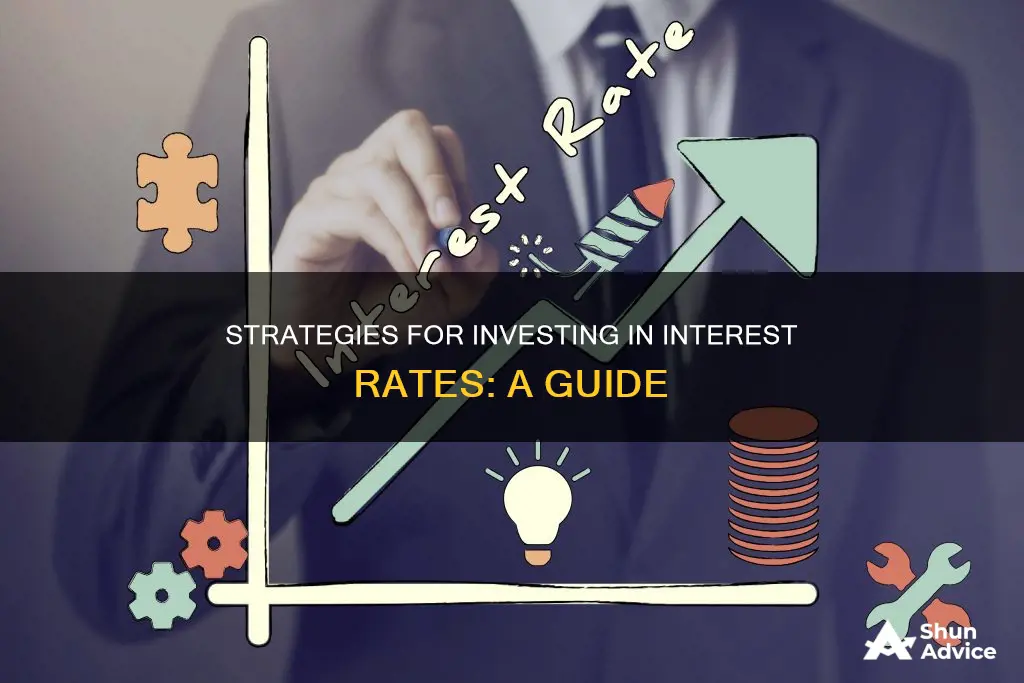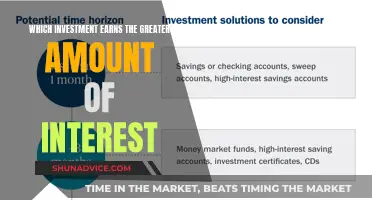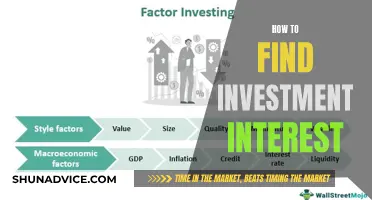
Investing in interest rates is a complex topic that requires careful consideration of various factors. With the unemployment rate slowly rising, the Fed must balance reducing interest rates with managing inflation. This can impact your investment portfolio, and you may be wondering if it's too late to make changes. It's important to have both short-term savings and long-term investments, and to consider repositioning funds in preparation for rate cuts. For example, investing in certificates of deposit (CDs) can offer a guaranteed crediting rate, but it's important to maintain liquidity and manage risk. The duration of your investment also impacts the interest rate, and there are strategies like laddering that can help manage liquidity. High-yield bonds or dividend-paying stocks may also be attractive options when interest rates decline.
| Characteristics | Values |
|---|---|
| Interest rate | The longer the duration, the higher the credited interest rate |
| Inflation | Interest rate cuts signal that inflation is coming under control |
| Investment | High-yield bonds or dividend-paying stocks may be appropriate investments when interest rates decline |
| Liquidity | Purchasing multiple certificates of deposit (CDs) with different maturity dates can maintain liquidity and protection against interest rate risk |
What You'll Learn

Repositioning funds in high-yield savings accounts
It is important to have both short-term savings and long-term investments. In preparation for rate cuts, you could consider repositioning some of the funds you have in high-yield savings accounts in certificates of deposit. These are known as CDs. CDs offer a set guaranteed crediting rate for a stated duration of time. You can consider purchasing CDs of varying maturities to lock in higher rates. By staggering the maturities of your CDs, you can maintain liquidity and protection against interest rate risk.
If liquidity is a prime concern, it may be prudent to purchase multiple CDs and utilize a strategy called "laddering", where each CD has a different length of time to maturity. CDs are insured up to $250,000 through either the Federal Deposit Insurance Corp. (banks) or NCUA (credit unions). Given that the highest-yielding CDs may be from riskier financial institutions, this can relieve any illiquidity anxiety.
If you're rebalancing and want to capture yield, high-yield bonds or dividend-paying stocks may be appropriate investments. These assets frequently offer better returns when interest rates decline.
Understanding the Magic of Compounding Interest on Investments
You may want to see also

Purchasing certificates of deposit (CDs)
CDs are insured up to $250,000 through either the Federal Deposit Insurance Corp (banks) or NCUA (credit unions). If liquidity is a prime concern, it may be prudent to purchase multiple CDs and stagger their maturities. This strategy is called "laddering" and can help maintain liquidity and protection against interest rate risk.
By purchasing CDs of varying maturities, you can lock in higher rates while also ensuring that your funds are not tied up for too long. This strategy can be particularly useful if you are concerned about the potential for rising interest rates in the future.
When considering purchasing CDs, it is important to keep in mind that the highest-yielding CDs may be from riskier financial institutions. Therefore, it is essential to carefully evaluate the risks and returns associated with different CDs before making a purchase decision.
Interest Rates: Impact on Investment Spending and the Economy
You may want to see also

Capturing high yield through CDs
One way to capture high yield is through certificates of deposit (CDs). CDs offer a set guaranteed crediting rate for a stated duration of time. At the end of the time period, called the maturity date, you can renew the CD at then-prevailing rates or end the investment. You can consider purchasing CDs of varying maturities to lock in higher rates. By staggering the maturities of your CDs, you can maintain liquidity and protection against interest rate risk.
If liquidity is a prime concern, it may be prudent to purchase multiple CDs and utilize a strategy called "laddering", where each CD has a different length of time to maturity. CDs are insured up to $250,000 through either the Federal Deposit Insurance Corp. (banks) or NCUA (credit unions). Given that the highest-yielding CDs may be from riskier financial institutions, this can relieve any illiquidity anxiety.
CDs are not liquid until the maturity date. However, the longer the duration, the higher the credited interest rate.
Rate cuts signal that inflation is coming under control, freeing up households to begin spending more on both consumable goods as well as big-ticket purchases, such as new cars, homes and major renovation projects. With lower interest rates, more people are able to qualify for a mortgage or other investments.
Investment Interest Expense: What Can Be Deducted?
You may want to see also

Investing in high-yield bonds or dividend-paying stocks
If you're looking to invest in high-yield bonds, it's important to understand the risks involved. High-yield bonds, also known as junk bonds, are issued by companies with lower credit ratings. While these bonds offer higher interest rates, they also come with a higher risk of default. It's crucial to carefully research the companies issuing these bonds and assess their financial health before investing.
On the other hand, dividend-paying stocks can provide a steady income stream. Dividends are payments made by companies to their shareholders, typically on a quarterly basis. When you invest in dividend-paying stocks, you become a part-owner of the company and are entitled to receive these payments. It's important to note that not all stocks pay dividends, and the companies that do pay dividends tend to be more established and stable.
When considering investing in high-yield bonds or dividend-paying stocks, it's essential to diversify your portfolio to manage risk effectively. This means investing in a variety of companies across different industries and sectors. By diversifying, you reduce the impact of any single investment on your overall portfolio and increase your exposure to different market trends.
Additionally, it's important to remember that investing in high-yield bonds or dividend-paying stocks is not without risk. While these investments can offer attractive returns, they are also subject to market volatility and economic conditions. As with any investment, it's crucial to conduct thorough research, understand the risks involved, and ensure that these investments align with your financial goals and risk tolerance.
Finally, when investing in high-yield bonds or dividend-paying stocks, consider working with a financial advisor who can provide guidance and help you make informed decisions. They can assist in assessing your financial situation, determining an appropriate asset allocation, and selecting investments that match your risk profile and investment objectives.
Interest Rates: Impact on Consumption, Investment, and Exports
You may want to see also

Comparing options with fewer moving parts
When it comes to investing in interest rates, there are a few options to consider. One option is to invest in certificates of deposit (CDs). CDs offer a set guaranteed crediting rate for a stated duration of time, and by purchasing CDs of varying maturities, you can lock in higher rates and maintain liquidity. Another option is to consider high-yield bonds or dividend-paying stocks, which can offer better returns when interest rates decline.
When comparing options with fewer moving parts, it is important to consider the duration of the investment and the potential return. For example, the longer the duration of a CD, the higher the credited interest rate. This makes CDs a relatively simple investment option to compare, as the interest rate is directly tied to the duration.
High-yield bonds and dividend-paying stocks can also be compared based on duration and potential return. However, these investments may be more complex due to the additional factors that can impact their performance, such as the financial health of the issuing company and market conditions.
It is also important to consider the level of risk associated with each investment option. CDs are considered a relatively low-risk investment, as they are insured up to a certain amount. High-yield bonds and dividend-paying stocks, on the other hand, may carry more risk, as their performance can be more volatile and they may not be insured in the same way as CDs.
Overall, when comparing options with fewer moving parts, it is important to consider the duration, potential return, and level of risk associated with each investment. By understanding these factors, investors can make more informed decisions about which options align with their financial goals and risk tolerance.
Mortgage Interest Rates: Higher for Investments?
You may want to see also
Frequently asked questions
You can invest in interest rates by purchasing certificates of deposit (CDs) of varying maturities to lock in higher rates.
CDs offer a set guaranteed crediting rate for a stated duration of time. By staggering the maturities of your CDs, you can maintain liquidity and protection against interest rate risk.
It is important to have both short-term savings and long-term investments. You should also be aware of the impact of interest rate cuts on inflation and household spending.
Yes, if you're looking to capture yield, high-yield bonds or dividend-paying stocks may be appropriate investments when interest rates decline.







